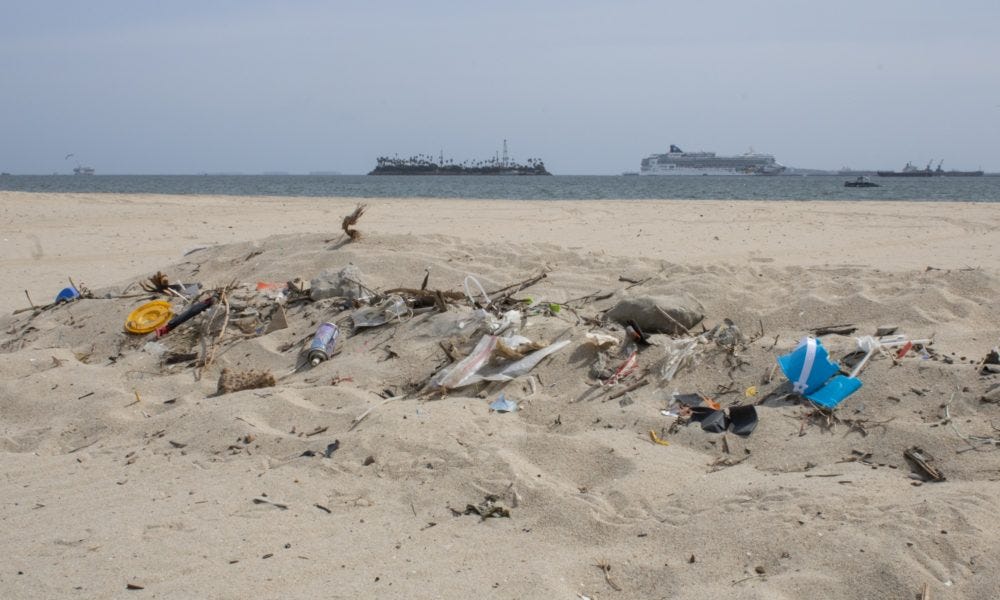A look at beach pollution in Southern California
If you’re a CSU student journalist or advisor, please fill out this survey to help me do a better job for you. It includes a when2meet link for our next Zoom meeting.
The Daily 49er’s Mikayla Schwartz originally wrote this story for their Earth Day edition. It is available for republication by CSU papers. If you think the Daily 49er’s work is important, please donate to keep their work going.
Trash is piled up on Granada Beach in Long Beach Wednesday, April 14. Photo credit: Andrea Ramos
Beach pollution in Southern California leads to environmental effects that can take the form of sewage spills, chemical contaminants and plastic or other trash, which is harmful to both people and marine life.
Within the last few months, two sewage spills have occurred in Long Beach causing beaches to shut down. In December 2020, 50,000 gallons of sewage discharged into the Los Cerritos Channel, and another 26,000 gallons discharged from the Los Angeles River on Feb. 22, causing beaches from Third Place to Belmont Pier to close.
According to Christine Whitcraft, a professor of biological science at Long Beach State, these sewage spills can have significant effects on neighboring communities.
“In the sewage that comes downrange from biological hazards and microplastics to more common everyday items like soaps, fats or even pesticides, a range of health problems come in from the coastal water,” Whitcraft said. “And that is why sewage spills make the news and shut down beaches — to make sure people aren’t swimming in the sewage.”
Whitcraft, who specializes in the human effects on coastal ecosystems, said that bacteria and bacterial diseases can arise from untreated wastewater. She emphasized that although many legacy contaminants, or chemicals, have been banned, many remain in our oceans.
“These are ones that reflect our past chemical use, like lead gasoline, that would hit urban streets and runoff and bind into sentiments,” Whitcraft said. “Legacy contaminants like PCB do not need high exposure to impact people. PCBs can accumulate at the bottom of oceans, streams and wetlands.”
PCBs, or polychlorinated biphenyls, are “man-made organic chemicals consisting of carbon, hydrogen and chlorine atoms,” according to the United States Environmental Protection Agency, and can be found in plastics, electrical equipment and other industrial items.
Common chemical pollutants that reach oceans include pesticides, herbicides, fertilizer, detergents and industrial chemicals. Large amounts of fertilizer can lead to algae blooms that create dead zones by pulling oxygen from the water.
Erika Holland, a professor of biological science at CSULB, explained that debris washes into to the ocean from rivers, and this runoff may consist of microplastic pieces, which can absorb chemicals that marine animals later consume.
“They can break down into smaller pieces that look very similar to organisms,” Holland said. “Plastics can pick up chemicals from the environment.”
She said that the consumption of plastic can damage the gut lining or gills, and “chemicals associated with plastic can cause psychological problems like endocrine disruption.” This was echoed by Gwen Goodmanlowe, marine biology lecturer and marine mammal expert at CSULB.
“As we develop these chemicals, we don’t know what the effects on wildlife are,” Goodmanlowe said. “By the time we find out and put a ban on them, they are in the environment. It’s really, really hard to get rid of them.”
An estimated 15 to 51 trillion particles of microplastic floats in oceans worldwide. According to a 2015 study, 25% of anthropogenic debris has been found in fish and shellfish in California.
Trash and debris in the ocean are often consumed by fish and birds, and sea turtles in particular often mistake plastic bags floating in the water for jellyfish, one of their main sources of food.
Heal the Bay, a nonprofit organization and aquarium, releases an annual Beach Report Card that scores beaches in the greater Los Angeles area based on their water quality. According to the 2019-20 report, most beaches in Long Beach scored mostly As and Bs for the summer and winter dry seasons, though many received Ds and Fs during the wet weather season, which is often when pollutants are washed into the ocean.
Three beaches in Los Angeles County made it to the Honor Roll, meaning they scored an A+ for all seasons: Palos Verdes Cove, Palos Verdes Long Point and Redondo State Beach at Topaz Street.
According to Whitcraft, Long Beach and its surrounding cities have removed concrete and put plants within rivers to filter out nutrients and contaminants in the water and reduce the amount of pollutants reaching the ocean.
All three experts maintained that one way to reduce the amount of pollution is to reduce overall plastic consumption, which can be done by changing the packaging of items.
“Cleaning it up is not the answer,” Goodmanlowe said. “It has to be prevented. That’s where the effort should be. It is preventing this plastic from being produced and put out into the environment.”




